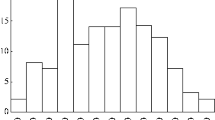Summary
The roles of the mechanosensory afferents from the wings, cerci, tergites and genitalia in copulation behavior were examined by ablation and stimulation in the male cricketGryllus bimaculatus DeGeer.
The sexually excited male cricket exhibited an intense posture (IP) upon contact stimulation of the elytra and the 4th to 9th abdominal tergites. This posture allowed the backward slipping (BWS) or hooking to take place subsequently.
Backward slipping (BWS), which is the movement to get under the female, was elicited during IP by contact stimulation to the middle and distal regions of the dorsal surface of the cercus.
Hooking, the coordinated movements for hanging the epiphallus onto the female's subgenital plate could be induced during IP by contact either on the dorsum, periproct or proximal 2 mm regions of the cercus. The latter two regions played a role in performing hooking accurately.
Among four types of mechano-sensilla on the cercus the trichoid type was crucial for the initiation of BWS and hooking. Calculations revealed that about 60 trichoid hairs (4% of all the trichoid hairs in one cercus) were sufficient for the male to carry out hooking normally.
The input from the bristle hairs on the epiphallus initiated the spermatophore extrusion (SPE) by swelling the endophallus.
These results demonstrated that copulation behavior in the male cricket consisted of several motor acts and each act is triggered by specific input from the contact-sensitive sensilla on the elytra, tergites, cerci and genitalia. The sequential execution of each motor act is achieved because one motor act results in a positional change in contact with the female which in turn gives rise to another act. This type of motor control is a model of the so-called chain reaction in instinct behavior.
Similar content being viewed by others
Abbreviations
- BWS :
-
backward slipping
- C :
-
cercus
- EN :
-
endophallus
- EP :
-
epiphallus
- EPc :
-
epiphallic convexity
- FW :
-
forewing
- H :
-
hook
- IP :
-
intense posture
- HW :
-
hindwing
- P :
-
pouch
- PP :
-
periproct
- SP :
-
spermatophore
- SPE :
-
spermatophore extrusion
- SEM :
-
scanning electron microscope
References
Bacon JP, Murphey RK (1984) Receptive fields of cricket giant interneurons are related to their dendritic structure. J Physiol 352:601–623
Beck R (1974) The neural and endocrine control of mating behavior on the male house cricket,Acheta domesticus L. Doctoral thesis of physiology submitted to the University of Nottingham
Bischof H-J (1975) Die keulenförmigen Sensillen auf den Cerci der GrilleGryllus bimaculatus als Schwerezeptoren. J Comp Physiol 98:277–288
Dumpert K, Gnatzy W (1977) Cricket combined mechanoreceptors and kicking response. J Comp Physiol 122:9–25
Edwards JS, Palka J (1974) The cerci and abdominal giant fibres of the house cricket,Acheta domesticus. I. Anatomy and physiology of normal adults. Proc R Soc Lond B 185:83–103
Gnatzy W, Tautz J (1980) Ultrastructure and mechanical properties of an insect mechanoreceptor: stimulus-transmitting structures and sensory apparatus of the cercal filiform hairs ofGryllus. Cell Tissue Res 213:441–463
Gregory GE (1965) On the initiation of spermatophore formation in the African migratory locust,Locusta migratoria migratoriodes Reiche and Fairmire. J Exp Biol 42:423–435
Heusslein R, Gnatzy W (1987) Central projections of campaniform sensilla on the cerci of crickets and cockroaches. Cell Tissue Res 247:591–598
Huber F (1955) Sitz and Bedeutung nervöser Zentren für Instinkthandlungen beim Männchen vonGryllus campestris L. Z Tierpsychol 12:12–48
Huber F (1965) Brain controlled behavior in orthopterans. In: Treherne JE, Beament JWL (eds) The physiology of the insect nervous system. Academic Press, New York, pp 233–246
Loher W, Rence B (1978) The mating behavior ofTeleogryllus commodus (Walker) and its central and peripheral control. Z Tierpsychol 46:225–259
Mika G (1959) Über das Paarungsverhalten der WanderheuschreckeLocusta migratoria R. and F. und deren Abhängigkeit vom Zustand der inneren Geschlechtsorgane. Zool Beitr Berl 4:153–203
Murphey RK (1981) The structure and development of a somatotopic map in crickets: the cercal afferent projection. Dev Biol 88:236–246
Murphey RK (1985) A second cricket cercal sensory system: bristle hairs and the interneurons they activate. J Comp Phyisol A 156:357–367
Palka J, Levine R, Schubiger M (1977) The cercus-to-giant interneuron system of crickets. I. Some attributes of the sensory cells. J Comp Physiol 119:267–283
Sakaguchi DS, Murphey RK (1983) The equilibrium system of the cricket: Physiology and morphology of an identified interneuron. J Comp Physiol 150:141–152
Schmidt K, Gnatzy W (1972) Die Feinstruktur der Sinneshaare auf den Cerci vonGryllus bimaculatus Deg. (Saltatoria, Gryllidae). III. Die kurzen Borstenhaare. Z Zellforsch 126:206–222
Shimozawa T, Kanou M (1984) The aerodynamics and sensory physiology of range fractionation in the cercal filiform sensilla of the cricketGryllus bimaculatus. J Comp Physiol A 155:495–505
Sihler H (1924) Die Sinnesorgane an den Cerci der Insekten. Z JbAnat 45:519–580
Tinbergen N (1951) The study of instinct. Oxford University Press, New York London
Tobias M, Murphey RK (1979) The response of cercal receptors and identified interneurons in the cricket (Acheta domesticus) to air streams. J Comp Physiol 129:51–59
Author information
Authors and Affiliations
Rights and permissions
About this article
Cite this article
Sakai, M., Ootsubo, T. Mechanism of execution of sequential motor acts during copulation behavior in the male cricketGryllus bimaculatus DeGeer. J. Comp. Physiol. 162, 589–600 (1988). https://doi.org/10.1007/BF01342634
Accepted:
Issue Date:
DOI: https://doi.org/10.1007/BF01342634



